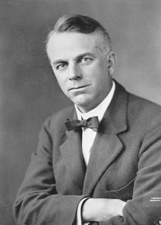William S. Kenyon (Iowa politician)
| William Kenyon | |
|---|---|
 |
|
| Judge of the United States Court of Appeals for the Eighth Circuit | |
|
In office January 31, 1922 – September 9, 1933 |
|
| Appointed by | Warren Harding |
| Preceded by | Walter Smith |
| Succeeded by | Charles Faris |
|
United States Senator from Iowa |
|
|
In office April 12, 1911 – February 24, 1922 |
|
| Preceded by | Lafayette Young |
| Succeeded by | Charles Rawson |
| Personal details | |
| Born |
William Squire Kenyon June 10, 1869 Elyria, Ohio, U.S. |
| Died |
September 9, 1933 (aged 64) Sagadahoc County, Maine, U.S. |
| Political party | Republican |
| Alma mater |
Grinnell College University of Iowa |
William Squire Kenyon (10 June 1869 – 9 September 1933) was a Republican U.S. Senator from Iowa, and a judge of the U.S. Court of Appeals for the Eighth Circuit.
Kenyon was born in Elyria, in Lorain County, Ohio. He moved to Iowa in 1870 and attended the public schools. After attending Grinnell College in Grinnell, Iowa, he graduated from the University of Iowa College of Law at Iowa City, Iowa, in 1890. After gaining admission to the bar in 1891, he commenced practice in Fort Dodge, Iowa, in Webster County.
He married Mary Duncombe in 1893, one year after beginning service as a prosecutor for Webster County. In 1894 he was elected Webster County Attorney, and served in that position for two periods, the second after the elected county attorney left to serve in the Spanish–American War.
He was elected to a judgeship of the eleventh judicial district of Iowa in 1900, and served for two years, before leaving to accept a position with his father-in-law, J. F. Duncombe, who was Iowa counsel for the Illinois Central Railroad. Kenyon succeeded his father-in-law as the railroad's Iowa counsel upon Duncombe's death in 1904. In 1908 Kenyon was promoted, and served as the railroad's general counsel for all lines north of the Ohio River. Then in 1910, he was appointed as an Assistant Attorney General of the United States.
Kenyon, relatively unknown in political circles, announced his candidacy for election to the U.S. Senate by the 1911 Iowa General Assembly. Considered "a conservative with progressive proclivities," he sought to wrest the seat away from fellow Republican Lafayette Young, who had been appointed by the governor upon the death of Jonathan P. Dolliver. On April 12, 1911, Kenyon was elected on the 67th ballot after a session-long stalemate, in which Young was his principal Republican adversary until the 23rd ballot. Kenyon was re-elected to the Senate in January 1913 (by legislative ballot) and November 1918 (by direct popular election, following ratification of the Seventeenth Amendment to the United States Constitution), defeating Democrat Charles Rollin Keyes, a noted geologist.
...
Wikipedia
